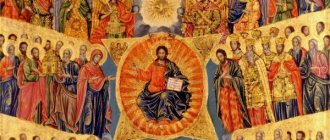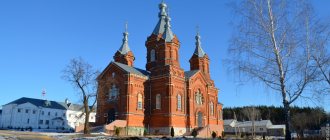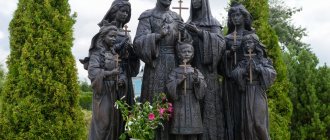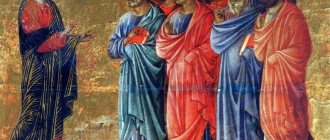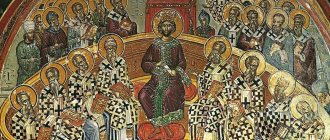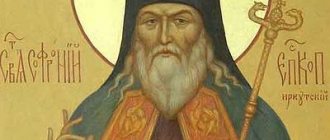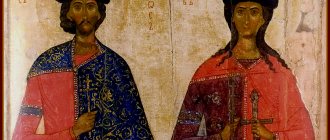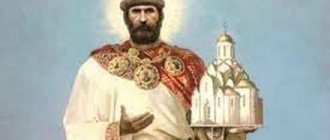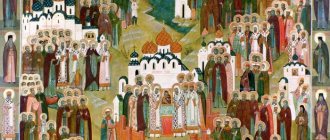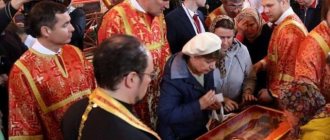Almost a year ago, the Council of Bishops adopted a document devoted to measures to preserve the memory of the new martyrs. During this time, the leadership of the Commission for the Canonization of Saints changed, and at the meeting of the Holy Synod held in early October, a detailed explanation was given on the work with the documents necessary for the glorification of the new martyrs. But some issues remained beyond the attention of the Synod.
The Secretary of the Synodal Commission for the Canonization of Saints, Hegumen Damascene (Orlovsky), told the Journal of the Moscow Patriarchate (No. 12, 2011) about them.
CHR I S T I A N S T V O
Metropolitan JUVENALIY
ABOUT THE SYNODAL COMMISSION OF THE RUSSIAN ORTHODOX CHURCH FOR THE CANONIZATION OF SAINTS
Dear conference participants, Beloved brothers and sisters!
Sacred Tradition is not only a collection of many written documents, it is the transmission of the life and experience of the entire Church, inspired and led by the Holy Spirit.
The spiritual heritage of the Church, as part of its Tradition, are the exploits of the holy saints of God. For about 20 years I have been directly involved in the grace-filled church work of glorifying the memory of the saints, which I want to share with you today.
Subjected to the most severe persecution in the 20th century, which in its scale and sophistication surpassed the persecution of the first Christians, the Russian Orthodox Church revealed to the Christian world a great host of ascetics of Orthodox piety, martyrs and confessors. In the conciliar consciousness of the Russian Orthodox people, all these years, a deep belief has been maintained that through the martyrdom and prayerful intercession of these ascetics, the Russian Orthodox Church is destined to withstand the trials that befell our country in the outgoing century.
Since the beginning of the 1960s, a number of canonization acts have been carried out in the Russian Orthodox Church. According to the tradition existing in the Church, saints canonized in individual Local Churches are included in the Monthly Books of other local Churches without repeating the act of canonization.
Thus, under His Holiness Patriarch Alexy I, the following names were included in the Months of the Russian Church: St. John the Russian Confessor and St. Nicodemus the Holy Mountain (+1809), canonized by the Church of Constantinople; glorified by the Romanian Orthodox Church Martyr Philothea (+1060), Venerable Nicodemus of Tisman (+1406) and Martyr John Wallach (+1662); saints of the Bulgarian Church - St. Paisius of Hilendar (XVIII century) and St. Sophronius of Vratsa (+1813).
In 1970, the Russian Orthodox Church canonized the missionary saint Nicholas of Japan (+1912) and included in its Months the Venerable Herman of Alaska, glorified by the American Orthodox Church.
In 1977, the canonization of the missionary saint Innocent, Metropolitan of Moscow, took place.
The Historical-Canonical Group, which began its activities in May 1981, within the framework of the Anniversary Commission for the preparation and celebration of the 1000th anniversary of the Baptism of Rus', prepared the canonization of nine ascetics of the Russian Orthodox Church, who personified the main types of holiness that exist in the Orthodox Church: the blessed Grand Duke Demetrius Donskoy , St. Andrei Rublev, St. Maxim the Greek, St. Macarius of Moscow, St. Paisius of Velichkovsky, Blessed Xenia of Petersburg, St. Ignatius Brianchaninov, St. Theophan the Recluse, St. Ambrose of Optina. The solemn canonization of these devotees of piety, carried out by the Local Council in June 1988, began a new page in the history of the canonization of saints of the Russian Orthodox Church of modern times.
The decision of the Local Council on the canonization of saints states: “We consider it necessary in the post-conciliar period to continue the work of studying further canonizations for the glorification of other ascetics of faith and piety who were revered by the people, a concern for which the Holy Synod will have.”
The church body entrusted with the implementation of this activity by the resolution of the Holy Synod of the Russian Church on April 11, 1989 was the Synodal Commission for the Canonization of Saints, which continues to carry out its responsible church obedience on an ongoing basis to the present day.
When the Commission was formed, its Chairman was given the authority to involve in cooperation in studying the issue of canonization of His Eminence archpastors, theologians of Theological schools, pastors and laity of the Russian Orthodox Church. Based on this, the best scientific forces of the Church took part in the work of the Commission. Secular scientists also provide invaluable assistance with their consultations.
The Synodal Commission for the Canonization of Saints prepared materials on the basis of which the Hierarchy (at the Local Councils of 1988 and 1990, as well as at several Councils of Bishops) glorified a number of saints of God, among whom Blessed Xenia and Saint Righteous John are especially highly revered among the Orthodox people Kronstadt, His Holiness Patriarch Tikhon and other new martyrs and confessors. The number of canonizations that have already taken place since 1988 (27 for all-Russian veneration) significantly exceeded the number of canonizations performed over the two centuries of the synodal era, including the period of the reign of Emperor Nicholas II, who stood out in comparison with his predecessors on the throne for his special zeal for veneration and glorifying the memory of the saints.
Depending on the prevalence of the veneration of the ascetic, he is glorified either as a general church saint, or as a locally venerated one (if his veneration does not go beyond the boundaries of a monastery or diocese). In the 90s, the practice of glorifying saints for local veneration, abandoned in the synodal era, was restored.
The approach to the canonization of locally revered saints uses the same criteria as for church-wide glorification.
The blessing to canonize an ascetic of the faith as a locally revered saint is given by His Holiness the Patriarch. The canonization of a locally venerated saint is carried out by the diocesan bishop in the order established in the Russian Orthodox Church.
The names of locally revered saints are not included in the general church calendar, and their services are not printed in general church service books, but are published in a separate publication locally.
The decision on the general church glorification of the saint belongs to the Local or Bishops' Council.
The main criteria for canonization of church-wide and locally revered ascetics of the faith in the Russian Orthodox Church are:
- righteous living;
Orthodoxy is impeccable;
popular veneration;
miracles;
and if there are any, then incorruptible relics.
Despite the variety of reasons and grounds for the canonization of saints in different periods of the existence of the Church, one thing remains unchanged: every glorification of saints is a manifestation of the holiness of God, it is always carried out with the blessing and will of the Church itself.
The Holy Synod on July 6, 1989 approved the developed methods and nature of the work of the Commission, and also approved the proposal according to which “the initiative to raise questions about canonization should come from the Holy Synod or from the ruling Bishops.” The laity, who venerate the ascetic of piety, turn to the ruling Eminence on all matters of his glorification. The Council of Bishops in 1989 approved this decision of the Synod.
In the 20th century, the Russian Orthodox Church brought to God a great host of martyrs and confessors who suffered for Christ. Currently, the main subject of research conducted within the framework of the Synodal Commission and the diocesan commissions for the canonization of saints formed in accordance with the resolution of the Council of Bishops in 1992 are materials related to the lives and exploits of Russian martyrs and confessors of the Soviet era, whose conciliar canonization should take place at the upcoming Jubilee Bishops' Council Cathedral on August 20. The church-wide glorification of the Council of new martyrs and confessors, known by name and those whose names remain unknown to people but known to God, implies the inclusion of locally glorified new martyrs in it. For the Council of Bishops, the Commission is also preparing materials for the glorification of other saints of God of the 20th century and an earlier era, who died peacefully, but through their prayerful and ascetic deeds, selfless archpastoral, pastoral or senile service, who, like the martyrs, showed an example of testimony to Christ the Savior (Metropolitan Macarius [Nevsky; 1835 - 1926], Archpriest Alexy Mechev [1859 - 1923], Hieroschemamonk Alexy [Soloviev; 1846 - 1928], Hieroschemamonk Seraphim Vyritsky [Muravyov; 1866 - 1949], 34 Reverend Martyrs of the Transfiguration Valaam Monastery [+ 1 578] , Metropolitan of Rostov Arseny [Matsevich; 1697 - 1772], Archimandrite Macarius [Glukharev; 1792 - 1847], priest Alexy Bortsurmansky [Gneushev; 1762 - 1848], abbot of the Kiziltash monastery Parthenius [1816 - 1867]).
The Council of Bishops in 1992 established the celebration of the Council of New Martyrs and Confessors of Russia of the 20th century on January 25 according to Art. Art. (if this date coincides with a Sunday) or on the next Sunday after that. In making such a decision, the Council was guided by the resolution of the All-Russian Local Council of 1917 - 1918, where in the Determination “On the events caused by the ongoing persecution of the Orthodox Church” it was established on this day to commemorate “all the confessors and martyrs who have died in the current fierce year of persecution.” January 25 was chosen for commemoration as the day of the martyrdom of Metropolitan Vladimir of Kyiv.
While studying materials about the new martyrs and confessors, the Committee encountered a number of problems, of which it seems appropriate to dwell on two of them.
One concerns the possibility of canonization of those injured clergy and laity who, for various reasons, separated from the Moscow Patriarchate. Having studied this issue, the Commission developed a document “Historical and canonical criteria on the issue of canonization of new martyrs of the Russian Church in connection with church divisions of the 20th century,” approved by the Hierarchy. The essence of our approach to this problem is that it is necessary to distinguish, on the one hand, schisms, the emergence of which is associated with deep ecclesiological errors bordering on heresy, or which were the result of criminal lust for power and the readiness to serve as a tool in the hands of the enemies of the Church in their plans aimed at to the destruction of church life, such as the Renovationist, Self-Saintly, Gregorian, and on the other hand, divisions associated with the activities of groups of so-called “non-rememberers”: participants in these groups of bishops, clergy and laity in opposition to the Deputy Patriarchal Locum Tenens, Metropolitan Sergius, breaking off communication with him because of disagreement with his church-political line, they did not break off communication with the head of the Church - the Locum Tenens of the Patriarchal Throne, Metropolitan Peter, who was in captivity. At the same time, most of these oppositionists from among the bishops retired and made no attempts to form another, alternative church center. However, some of the “non-rememberers” made such attempts.
The commission came to the conclusion that the canonization of the Renovationists, Grigorievites, self-saints and others like them, even if they suffered during the years of persecution, is impossible, since by their criminal actions they placed themselves outside the saving fence of the One Holy Catholic and Apostolic Church. But the Commission did not see any canonical obstacles to the glorification of those oppositionists who, having stopped raising the name of the Deputy Locum Tenens, remained in prayerful communion with the Patriarchal Locum Tenens and did not take steps towards the formation of a parallel church center. More complicated is the question of the possibility of canonization of oppositionists who could not resist attempting to form or lead an alternative church center. The commission still has to conduct a thorough historical and canonical study of the possibility of their canonization.
Another difficult issue that the Commission faces when considering materials related to repressions against clergy and laity is that when familiarizing itself with the contents of the relevant documents of the repressive bodies, it turned out that during interrogations and under torture by investigators, some of the victims behaved imperfectly, signed interrogation protocols with self-incrimination, or even with the names of imaginary accomplices in the case, as a result of which the incriminated persons, in turn, were also subjected to repression.
Since there should be no mistakes in the holy work of glorifying the saints of God, in the case where incriminating material contained in investigative or judicial cases cannot be unconditionally rejected as devoid of any reliability, the Commission cannot conclude that there are no obstacles to canonization. But such a decision, of course, does not have a final nature, excluding the possibility of canonization of the injured clergy or layman in the future. If further research reveals obvious unreliability of information gleaned from investigative cases that prevented the canonization of the victim, the question of his glorification may receive a positive decision.
The difficulties with canonization that I spoke about mainly occur in connection with the repressions of the 30s, and especially 1937-1939. Such a problem practically does not arise if one considers the exploits of victims of repression during the civil war, when reprisals against clergy were carried out without the hassle of citing legal grounds and without resorting to the fabrication of incriminating materials, and therefore without forcing those arrested to testify against other persons.
There has been widespread interest in the issue of the possible canonization at the upcoming Council of Bishops of Emperor Nicholas II and members of his family, who were shot in Yekaterinburg on the night of July 17-18, 1918. By the definition of the Council of Bishops from March 31 to April 4, 1992, the Synodal Commission for the Canonization of Saints was instructed “in studying the exploits of the new Russian martyrs to begin researching materials related to the martyrdom of the Royal Family.” Over the course of a number of years, the Commission carefully examined materials related to the life and martyrdom of the Royal Sufferers and to the state activities of Emperor Nicholas II. The problems with which possible difficulties could be associated with a positive solution to the issue of glorifying the Royal Martyrs as saints were studied with particular care, in particular, fundamentally important moments in the state and church policies of the Emperor, the relationship of the Royal Family with Rasputin, the circumstances of the Tsar’s abdication in context of the legal structure of the Russian state.
The Commission saw its main task in the issue of canonization of the Royal Family in an objective examination of all the circumstances of the lives of members of the Imperial Family in the context of historical events and their church understanding outside the ideological stereotypes that have dominated our country over the past decades. The commission was guided by pastoral concern so that the canonization of the Royal Family in the host of Russian new martyrs would not provide reasons and arguments for political struggle or worldly confrontations, but would only contribute to the unification of the people of God in faith and piety. We also sought to take into account the fact of the canonization of the Royal Family by the Russian Church Abroad in 1981, which caused a far from unambiguous reaction both among the Russian emigration and in Russia itself, not to mention this decision of the Russian Orthodox Church Outside of Russia, which has no historical analogies in the Orthodox Church, as the inclusion in the number of canonized people who, together with the Royal Family, accepted the martyrdom of the royal servant, the Roman Catholic Aloysius Yegorovich Troupe, and the Lutheran goblettress Ekaterina Adolfovna Schneider.
In 1994 and 1997, I reported to members of the Councils of Bishops on the results of studying the above topics. Since that time, no new problems have appeared in the issue under study, although the controversy continues to this day.
The commission came to the conclusion that in the state and church policies of the last Russian Emperor there is in itself no basis for his canonization, but that Christian patience with suffering after his arrest and the martyrdom of the Tsar and members of his family make it possible for them to be glorified as holy passion-bearers, similar to the holy princes Boris and Gleb, Andrei Bogolyubsky, Mikhail Tverskoy, Tsarevich Dimitri. This conclusion was approved by the Holy Synod and the Council of Bishops in 1997.
Many appeals with approval regarding the glorification of the Royal Martyrs were received by His Holiness Patriarch Alexy II, the Holy Synod and the Synodal Commission for the Canonization of Saints. In some dioceses the issue of canonization was discussed at diocesan, deanery and parish meetings. They expressed support for the thought and glorification of the Royal Martyrs. Some appeals have the signatures of several thousand people. Among the authors of such appeals are Russian emigrants, as well as clergy and laity of the fraternal Orthodox Churches. The idea of the need for the speedy glorification of the Tsar and the Royal Martyrs was expressed by a number of church and public organizations.
Of particular value are publications and appeals to the Commission and other church authorities, containing testimonies of miracles and grace-filled help through prayers to the Royal Martyrs.
The Commission, in its approach to this topic, strives to ensure that the upcoming glorification of the Royal Martyrs does not separate, but unites people. And for this, the act of canonization must be free from any political or other conjuncture. In this regard, it seems necessary to specially emphasize that the canonization of the Monarch is in no way connected with monarchical ideology and, moreover, does not mean the “canonization” of the monarchical form of government, which can, of course, be treated differently. The activities of the head of state cannot be removed from the political context, but this does not mean that the Church, when canonizing a Tsar or a prince, as it did in the past, is guided by political or ideological considerations. Just as the acts of canonization of monarchs that took place in the past were not of a political nature, no matter how biased enemies of the Church interpreted these events in their tendentious assessments, so the upcoming glorification of the Royal Martyrs will not have a political nature, for in glorifying the saint, the Church does not pursue political goals, which she actually does not have by the nature of things, but testifies before the people of God who already honor the righteous man that the ascetic she canonized really pleased God and stands before the Throne of God for us, regardless of what position he occupied in his earthly life: whether he was from these little ones, like the holy righteous John of Russia, or from the mighty of this world, like the holy emperor Justinian. By performing canonization, the Church reveals his real holiness and gives official sanction to his veneration, which already existed at the time of glorification among pious people. These principles guide the Commission I head in its approach to glorifying the Royal Martyrs.
The conciliar glorification of the host of named and unnamed new martyrs and confessors of Russia will undoubtedly be the greatest church act of the outgoing millennium.
Concluding my speech, I would like to wish the participants of the conference God’s help in their work that is necessary for the Church in the field of church historical science.
Veto for 75 years
— There is a 75-year ban on researchers’ access to archival files from the period of the existence of the USSR. They can only be studied by the repressed themselves, their relatives, as well as researchers who have received personal permission from them. But these relatives cannot always be found (for example, women sometimes change their last names when they get married) or they have died. What do the commission members do in this case?
— In accordance with the law, relatives of the repressed person or their representatives can only get acquainted with materials directly related to their relative, that is, with part of the case, but the commission considers only the complete case. The Synodal Commission does not conduct research on materials relating to certain repressed persons with the aim of including their names in the Council of New Martyrs and Confessors of Russia. The commission carries out a check and some additional research on the materials sent by the dioceses.
— How do you assess the results of the February Council of Bishops and its position on work with the new martyrs?
— The Council of Bishops encouraged the church society to discuss issues related to the study of the feat of the new martyrs. It revealed a wide range of opinions related to this issue; its discussion intensified work on the creation of an ecclesiastical and scientific document, adopted by the Holy Synod on October 5-6, 2011 as mandatory: “Recommendations for the activities of diocesan commissions for the canonization of saints in the dioceses of the Russian Orthodox Church.” This document summarizes the accumulated experience, gives clear definitions of what criteria are used to study and make decisions, what set of documents is needed to make decisions, and indicates that when studying materials relating to the new martyrs, one must take into account state legislation and correlate one’s actions with it. The recommendations adopted by the Holy Synod concern not only the new martyrs, but also the canonization of the righteous and ascetics of piety.
— The documents of the February Council of Bishops say that “it is advisable to formulate proposals for an objective reflection of the topic of new martyrs and confessors in modern history textbooks.” Which textbooks - school or university?
“These are, first of all, textbooks for schools, and the topic of the new martyrs should be in these textbooks. The caution of society when discussing the issue of textbooks on the Fundamentals of Orthodox Culture is explained by fears that, under the guise of “Fundamentals,” compulsory teaching of the Law of God in schools is being introduced. But the introduction of material about the facts of history that this society experienced in the recent past cannot cause any protest.
This is part of our history, here church history is so intertwined with secular history that it has already become almost one whole. Everyone knows that the decades of the Soviet era were associated with repressions, most brutally directed against the Russian Orthodox Church. The beginning of the civil war and the execution in 1918 of Metropolitan Vladimir of Kiev and Archbishop Andronik of Perm, the famine and confiscation of church valuables in 1922 and the trial of Moscow priests with subsequent executions, and the execution of Metropolitan Veniamin of Petrograd, Lenin’s “Shuya letter” and execution are perceived as one historical event priests - Shuya Pavel Svetozarov and Palekh Ioann Rozhdestvensky.
— Do you agree with the opinion that the expected veneration of the new martyrs did not happen in our Church? And what needs to be done to correct this situation?
“This could have happened if we had continued to live in an era of persecution; then we would keenly empathize with their suffering. But we live in a different era, which, although not far from that in time, is infinitely far away in the content of the life around us. The era of the new martyrs is already a different era relative to our time. And therefore, the veneration of the new martyrs can take place, like the veneration of saints in general, only through a deliberate study of their feat.
— In one interview, you said that now we poorly understand the significance of the feat of the martyrs and thus do not demonstrate such a Christian virtue as gratitude. We are blind in the sense that we do not see the danger of our existence in the present time. What do you think is the danger?
— When there is no freedom, when it is limited by state power, as it was in Soviet times, a person finds himself constrained in his creative activity. He may have wanted to do something for society, but he couldn’t. But when limiting obstacles are removed, a person becomes free in his activities. When he was limited, he could do nothing, create nothing and say that the law did not allow him to do this. But when the framework of the law, which acts restrictively on social and church activities, is removed, how can he justify that even when external circumstances change, he also does nothing?
Some people, although dissatisfied with modern life, and they don’t like much about it, live in a strange expectation that someone will come and arrange everything. But living this way, you can only wait for God’s judgment. To whom little is given, little will be required, and to whom much will be required, much will be required. Our society has been given a lot. We are blind because we often do not see what needs to be done, and we are blind because we do not see how dangerous it is to be voluntarily blind, since in this case the sin of not doing remains entirely on us, for whoever knows how to do good and does not do it, it is a sin for him (James 4:17).
— Who and where in the dioceses, in your opinion, is carrying out serious work on canonization, which dioceses would you mention?
— Materials about the new martyrs in Optina Hermitage were studied better than others, where a conscientious, scientific and ecclesiastical approach, a consistent search for historical truth turned out to be at the highest level. In the Moscow diocese, where the basis was based on what turned out to be the only correct method of studying the entire forensic investigative fund, where researchers did not stop at the total volume of the fund, consisting of 96 thousand forensic investigative cases. This work took eight years, but it made it possible to draw serious conclusions and use them in the future in the study of judicial investigation cases with the aim of including the names of the injured clergy and laity in the Council of New Martyrs and Confessors of Russia. A highly scientific and ecclesiastical approach was demonstrated by the St. Petersburg diocese, and the Ekaterinburg diocese showed a desire for objective historical research.
— How is work going on your multi-volume book dedicated to the martyrs and confessors of the Russian Orthodox Church of the 20th century?
— Working on a multi-volume book is a very complex study, since it involves studying the life of each martyr and confessor, the primary documents testifying to his life from birth to death. This is a labor-intensive study, where the search for documents may not be commensurate in terms of time and effort with the results obtained. But any scientific, including church, research is based on this: regardless of the visual result - it can be large or insignificant in terms of information content - the scientist must examine all the material. Currently, work is being completed on the seventh volume of the Lives of the New Martyrs and Confessors, whose memory is celebrated in July.
Links
Commissions Biblical and theological • On the canonization of saints • Divine services • On interaction with the museum community • On family issues, protection of motherhood and childhood • On physical education and sports • On Old Believer parishes and interaction with the Old Believers Other Publishing House of the Moscow Patriarchate • Synodal Library • Synodal Choir • Council for Perpetuating the Memory of New Martyrs and Confessors
Canonization is not a private matter for the saint’s family
In response to the publication “Are there any relatives of yours among the new martyrs?” A woman approached us with the following question: “My grandfather was a priest, he was repressed and shot. I interviewed my relatives and collected some information about him - when he was born, where he served, etc. It is obvious that he suffered for his faith. I heard that for canonization it is very important that the person during the investigation does not incriminate anyone or betray anyone. I am going to contact the FSB archive with a request to show me the investigative file, and if it turns out that my grandfather really did not betray anyone, can I contact the Canonization Commission so that he can be glorified as a new martyr and confessor and what should I do for this? »
We asked the author of the publication about the new martyrs, Marina Nefedova, to look into this issue:
In 1989, the Synodal Commission for the canonization of saints of the Russian Orthodox Church was formed. The main result of the activities of this Commission was the preparation of the canonization of “the new martyrs and confessors of Russia of the 20th century known by name and not yet revealed to the world, but known to God.” At the Jubilee Council of Bishops in 2000, 1097 people were glorified by name, and in the post-conciliar time, by decisions of the Holy Synod, they were included in the host of glorified holy names of those of them whose feat was studied after the Jubilee Council (to date, more than 500 more people have been added) Thus, in the host of new martyrs, 1608 ascetics are now glorified by name. Canonization and the collection of information necessary for it is a long process. Here is what Archpriest Georgy Mitrofanov, a member of the Canonization Commission, rector of the Church of the Apostles Peter and Paul at the Academy of Postgraduate Pedagogical Education in St. Petersburg, professor of St. Petersburg Academy of Sciences and Sports, says about this: “The main criteria for canonization of ascetics of the faith in the Russian Orthodox Church are: righteous living, Orthodoxy impeccable, popular veneration, miracles, and if there are any, then incorruptible relics. Following the ancient church tradition, only those who have accomplished the feat of martyrdom and confession immaculately, without incriminating themselves or others in fictitious crimes, are offered for glorification as new martyrs and confessors of Russia. Therefore, one of the common reasons why an injured member of the Church cannot be glorified as a saint is the slander of his comrades in his cause or self-incrimination. The consequence of such a slander was often the arrest, imprisonment and death of innocent people. Cowardice shown in such circumstances cannot serve as an example. One who was called by God to suffer for His sake and did not stumble can be numbered among the ranks of the new martyrs.” The application for canonization must come from the diocesan bishop of the diocese where the person suffered. Almost all dioceses now have a diocesan Commission for Canonization. This Commission examines the material and draws up a draft biography of the ascetic. Since the person has become a victim of repression, it is necessary that the materials of the investigation case be presented. To compile a more detailed biography, diocesan archives (service records of the clergy) are used, and clergy records are studied. After this preliminary work of the diocesan Commission, the materials, which are accompanied by a letter from the diocesan bishop, are sent to the synodal Commission on Canonization. Relatives can also begin collecting information and documents about the victim, but consideration of this issue by the Church is sanctioned by the bishop. “It is not entirely appropriate to offer your relatives for canonization,” says Father George. “There is some ambiguity here: “my relative suffered, but if he is canonized, then I will be a relative of the saint, so I raise before the Church the question of glorifying my relative.” Some believe that canonization is a type of perpetuation of memory. And this is absolutely not true. Canonization is church veneration of an ascetic, and not just the identification of worthy people. It is not family tradition, but church tradition that should determine the decision on the issue of canonization. Canonization is not a private matter of the family, but a matter of the Church. If relatives have collected material, they must provide it to the clergy, priest or bishop, so that it comes from the hierarchy. Unfortunately, now the majority of our population does not want to know its past and does not feel its historical roots. Unfortunately, we do not yet have widespread popular veneration of the new martyrs in our Church. In the early 90s, I collected materials about one executed priest, searched through the archives, and when I found his granddaughter and came to her, it turned out that I knew much more about her grandfather than she herself. And this happens very often." According to Professor N.E. Emelyanov, Doctor of Physical and Mathematical Sciences, head of the Department of Informatics of the Orthodox St. Tikhon's Humanitarian University, which has been collecting information about those who suffered for their faith in the 20th century for more than 15 years, there were supposedly about 500 thousand such victims Human. Now the Database created at the Department of Informatics of PSTGU, in addition to 1608 canonized ascetics, contains information about more than 28 thousand priests and laity who suffered during the persecution of the Church. We wrote in the magazine and on the NS website how to collect materials and where to start searching for information about your affected relatives. Information collected in the already mentioned PSTGU Database can help facilitate the search. You can also find out information at the Department of Informatics of PSTGU by calling 951-97-70 and supplement it if you know more about your relative than is available in the Database. Together with the Department of Contemporary History of the Russian Orthodox Church, investigative cases are being investigated, the Database is constantly being updated. If you would like to get acquainted with the investigative file of your injured relative, you need to write a request to the regional FSB department for the region from which he was arrested, or to the central archive of the FSB (Moscow, Kuznetsky Most 22) with a request to familiarize yourself with the investigative file. The request must include your full name, date and place of birth, as well as when and where you were arrested. Within a month, the request is usually granted, but on the condition that you prove your relationship (by presenting a chain of documents from the registry office). You also need to keep in mind that approximately a quarter of the cases are not found. In addition, you can contact the Information and Analytical Center of the Ministry of Internal Affairs of Russia (Moscow, Novocheremushinskaya St., 67). Here is a summary file of all those arrested up to this day. Professor N.E. Emelyanov: “This is the correct attitude that glorification should begin with local veneration. For example, the rector of a church learns that a priest who previously served here suffered, information about him is collected by parishioners, his memory begins to be revered, then the information goes to the bishop, and through the bishop it ends up in the Canonization Commission. If there is local veneration, then this is a very important reason for canonization. It is also natural and very correct for relatives to collect materials. At our department we keep many letters from relatives about their findings. Often sons and grandsons, having retired, devote all their energy to searching for information about their injured relatives. If you go to the places of service of repressed priests, you can find people who were somehow connected with them, and you can learn some information about your dead relatives from them. Unfortunately, such witnesses are becoming fewer and fewer.” In the matter of canonization, there is one very difficult question that has confronted researchers. This is a question about the criteria of holiness as applied to new martyrs. It has always been the case in the history of the Church that if a person accepted martyrdom for his faith, then he is a saint. In ancient times, the question before Christians was usually posed quite clearly - either you confess Christ and accept death, or you renounce Him and the Church, and thereby save your life. Proving that a person in the 20th century suffered specifically for his faith is often difficult - most of the victims, including priests, were convicted under political charges. They were often not required to directly renounce Christ. Many researchers in matters of self-incrimination or naming the names of other people during investigations believe that investigative cases cannot be trusted unconditionally - it is no secret that they were often fabricated. “To understand what you can believe and what you can’t, you need to see a lot of investigative cases,” says Lidiya Alekseevna Golovkova, an employee of the Department of Contemporary History of the Russian Orthodox Church. Russian new martyrs often needed to show courage not only in order to recognize themselves as Christians, but also in order to understand the intricacies of the investigators. At the same time, it happened that people who fell away from the Church also died, and it is impossible to consider all those who died at that time as martyrs. Therefore, canonization requires a very serious study of the circumstances of the life and death of each victim. In the post-conciliar period, the Council of Bishops decided to carry out “the name inclusion into the already glorified Council of the new martyrs and confessors of Russia with the blessing of His Holiness the Patriarch and the Holy Synod, on the basis of preliminary studies conducted by the Synodal Commission for the Canonization of Saints.” Meetings of the Holy Synod take place once every few months, and the decision with a list of saints by name, numbered among the host of new martyrs and confessors of Russia, is attached to the materials of the meeting of the Synod and published in various church publications, in particular, in the Diocesan Gazette. Also, all the definitions of the Holy Synod on the canonization of the New Martyrs and Confessors with the name list of glorified saints can be seen on the already mentioned website of St. Tikhon’s University. In addition to the named saints, the Council glorified all the ascetics “until now not revealed to the world” who suffered for the faith. No information has been found about the feat of many of the martyrs who suffered then, no documentary evidence has been preserved about some of them, and perhaps we will never know about some of them in this earthly life. But with God they are all glorified, and the Lord knows the names of all his saints.
compound
- Bishop Pankratius of Trinity, abbot of the Holy Transfiguration Valaam Monastery, chairman;
- Archbishop Evgeniy of Vereisky, rector of Moscow theological schools;
- Archbishop John of Kherson and Tauride, Chairman of the Commission for the Canonization of Saints of the Ukrainian Orthodox Church;
- Archbishop of St. Petersburg Ambrose, rector of St. Petersburg theological schools;
- Bishop Peter of Ungheni and Nisporeni, Chairman of the Commission for the Canonization of Saints of the Moldavian Land;
- Bishop Barnabas of Pavlodar and Ekibastuz, Chairman of the Commission for the Canonization of Saints of the Metropolitan District in Kazakhstan;
- Archimandrite Alexy (Polikarpov), abbot of the Danilov Stavropegic Monastery in Moscow;
- Archimandrite Nikodim (Generalov), Chairman of the Commission for the Canonization of Saints of the Belarusian Exarchate;
- Hegumen Damascene (Orlovsky), cleric of Moscow;
- Archpriest Vladimir Vorobyov, rector of the Orthodox St. Tikhon's Humanitarian University, secretary;
- Archpriest Vladislav Tsypin, professor of the Moscow Theological Academy;
- Archpriest Kirill Kaleda, cleric of Moscow;
- Archpriest Maxim Maximov, cleric of the Moscow diocese;
- Archpriest Oleg Mitrov, cleric of the Moscow diocese;
- Abbot Nektariy (Blinov), abbot of the Holy Trinity St. George Monastery in Chirchik (Uzbekistan);
- Zvyagin V.N., Doctor of Medical Sciences, Professor of the Federal State Budgetary Institution “Russian Center for Forensic Medical Examination” of the Ministry of Health of Russia.
Holy Synod at its meeting on October 22, 2015[5] decided: to include in the Commission the rector of the Moscow Theological Academy and Seminary, Archbishop Eugene of Vereisky, and the rector of the St. Petersburg Theological Academy and Seminary, Archbishop Ambrose of Peterhof; relieve Bishop Stefan of Gomel and Zhlobin from membership in the Commission and include the newly appointed chairman of the Commission of the Belarusian Exarchate, Archimandrite Nikodim (Generalov), in the Synodal Commission; to appoint the rector of the Orthodox St. Tikhon's Humanitarian University, Archpriest Vladimir Vorobyov, to the post of secretary of the Commission, releasing him from this post, with the retention of Abbot Damaskin (Orlovsky) as a member of the Commission.
lineup 2013
The composition was approved by the decision of the Holy Synod of March 12, 2013[6].
- Bishop of Trinity Pankraty (Zherdev), vicar of the Moscow diocese - Chairman of the Commission;
- Archbishop of Kherson and Tauride John (Siopko), Chairman of the Commission for the Canonization of Saints of the Ukrainian Orthodox Church;
- Bishop of Gomel and Zhlobin Stefan (Neshcheret), Chairman of the Commission for the Canonization of Saints of the Belarusian Exarchate;
- Bishop Peter (Musteata) of Ungheni and Nisporeni, Chairman of the Commission for the Canonization of Saints of the Moldavian Land;
- Bishop of Pavlodar and Ekibastuz Varnava (Safonov), Chairman of the Commission for the Canonization of Saints of the Metropolitan District in Kazakhstan;
- Archpriest Vladimir Vorobyov, professor, rector of the Orthodox St. Tikhon Humanitarian University - secretary of the Commission[7];
- Archimandrite Alexy (Polikarpov), abbot of the Danilov male stauropegial monastery in Moscow;
- Abbot Damascene (Orlovsky), cleric of the city of Moscow - from July 27, 2011 to October 22, 2015, Secretary of the Commission;
- Archpriest Vladislav Tsypin, professor of the Moscow Theological Academy;
- Archpriest Kirill Kaleda, cleric of the city of Moscow;
- Archpriest Maxim Maximov, cleric of the Moscow diocese;
- Archpriest Oleg Mitrov, cleric of the Moscow diocese;
- Abbot Nektariy (Blinov), abbot of the Holy Trinity St. George Monastery in the city of Chirchik (Uzbekistan);
- Zvyagin Viktor Nikolaevich, Doctor of Medical Sciences, Professor of the Federal State Budgetary Institution “Russian Center for Forensic Medical Examination” of the Ministry of Health of Russia.
sources
- Synodal Commission for the Canonization of Saints (official website)
- Synodal Commission for the Canonization of Saints // Patriarchia.ru
Footnotes
- Canonization of saints in the Russian Orthodox Church
- The act of canonization of Metropolitan of Kiev and Galicia Vladimir (Epiphany; 1848-1918), Metropolitan of Petrograd and Gdov Veniamin (Kazan; 1873-1922) and others like him murdered Archimandrite Sergius (Shein; 1866-1922), Yuri Novitsky (1882-1922) and Ioanna Kovsharov (1878-1922), Grand Duchess Elizabeth (1864-1918) and nun Varvara (1918)
- They have no shame. Is it necessary to change the criteria for the canonization of repressed clergy and how exactly?
- Synodal Commission for the Canonization of Saints // Patriarchia.ru
- magazine No. 72
- The new composition of the Synodal Commission for the Canonization of Saints has been approved / News / Patriarchy.ru
- Synodal Commission for the Canonization of Saints. Official website of the Moscow Patriarchate
